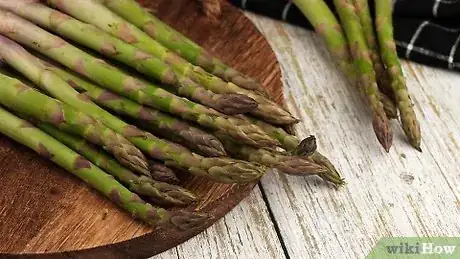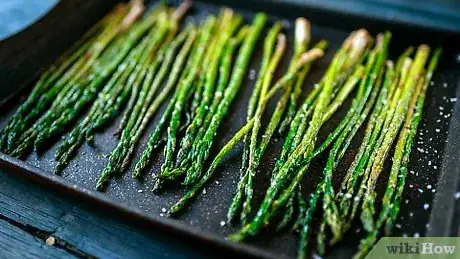This article was co-authored by Sasha Reyes. Chef Sasha Reyes is the Executive Chef and Owner of Artisan Personal Chefs. With over 20 years of food industry experience, she specializes in private dinner parties, custom sports nutrition plans for professional athletes, and cooking lessons. Chef Reyes graduated from Arizona Culinary Institute in 2011 with a degree in Culinary Arts, Baking, and Restaurant Management.
This article has been viewed 142,516 times.
There are many ways to eat asparagus. You can serve it hot, cold, raw, or cooked. You can use it to fill out a main entrée, or you can serve it as a side dish. It mixes well into soups, salads, casseroles, and stir-fries, but you may decide to simply serve it on its own! Read on and learn how to choose, store, and serve this versatile vegetable.
Steps
Choosing and Storing Asparagus
-
1Buy asparagus from a grocery store or farmers market. Fresh asparagus is a luxury vegetable, and its prices tend to reflect this. You can buy fresh, frozen, or canned asparagus. If you're buying fresh, look for bright green or violet-tinged spears. Spears should be straight, firm, and uniformly-sized, with closed (not flowering) tips. Ideally, buy fresh asparagus on the day that you plan to use it.[1]
- Asparagus spears range from thick to thin. Some people prefer one kind over another, but size does not generally signal quality or flavor. Thicker spears are more mature, and thinner spears less so. Thicker spears often have tougher, woodier ends, and most people chop these off before cooking.
- Asparagus goes bad quickly, so it’s important to pick bundles that are refrigerated or on ice. Do not buy asparagus that isn't being kept cool, as it may go bad even more quickly.
-
2Know when to buy fresh asparagus. Asparagus is one of the first green vegetables to come into season at the end of winter. Fresh, American-grown asparagus often appears in stores in late February, but the vegetable is at its best – and is usually cheapest – in April and May. You can eat frozen or canned asparagus year-round, but many consider fresh asparagus a delicacy.[2]Advertisement
-
3Store asparagus in a refrigerator or on ice. Use asparagus within two or three days of purchase, and preferably sooner. If you do need to keep it for a day or two, the best way to preserve the spears is to place them upright in a bowl (or even a small vase) of cold water. You can wrap the ends of the spears in a damp paper towel and refrigerate them. You can refrigerate them in a plastic bag for up to three days.
-
4Consider blanching asparagus before you freeze it. Blanching is an important step in preparing vegetables for freezing. Scalding the vegetables stops the enzymes that break the vegetable down. This may help preserve flavor, crispness, and color. Blanching before freezing also cleans the surface of the vegetable, slows the loss of vitamins, and makes the veggies softer and easier to pack.
-
5Consider growing your own asparagus. You can start these plants from seeds, or you can plant their crowns for faster results. Mature asparagus plants yield spears every spring for 12 to 25 years.
Main Ways to Cook Asparagus
-
1Steam your asparagus. Cut off the ends of the asparagus if the spears are thick. You can snap it off where the asparagus bends naturally or you can trim off the touch end. Then, using a standard vegetable peeler, peel the bottom portion 2-3 inches to ensure a tender and flavorful asparagus. Wash the asparagus. Fill a large pot with a couple inches of water and place a vegetable steamer into the pot. The water should not seep through the holes in the steamer; if it does, pour some water out of the pot. Put the asparagus in the pot and bring to a boil. Steam until soft or until you reach the texture you want.
- Consider serving steamed, grilled, or roasted asparagus as the first course at dinner. It is traditionally served with fresh-melted butter or freshly-made Hollandaise sauce. Eat with forks or fingers.
- Asparagus gets soft and moist when you steam it, and the result can taste bland. Add salt and other seasonings to spice up the flavor. Bear in mind that even though asparagus is very healthy, adding tons of salt and other seasonings may offset the health factor.
-
2Grill your asparagus on an outdoor grill. Cut the the ends of asparagus if the spears are thick. Wash the asparagus. Make a "boat" with aluminum foil for the asparagus to go in; the sides should be high enough to prevent the oil and asparagus from spilling over. Pour 1–2 tablespoon (14.8–29.6 ml). of olive oil into the aluminum foil "boat", and lay the asparagus in on top. Place the "boat" on an outdoor grill on medium heat until the spears reach the texture you want.
- Asparagus gets tougher when you grill it, but it still retains all of its moisture. The best part is that when it's cooked, you don't lose any nutrients!
- This is one of the simplest, tastiest ways to eat asparagus if you don't want to work it into a more complicated recipe.
-
3Grill asparagus on a griddle. Trim the spears and drizzle them with a bit of olive oil and seasoning. Toss the spears and seasoning in a bowl to mix. Then place the asparagus onto a hot griddle pan; ridged is ideal, but a flat iron skillet will do. Leave on a medium heat until blackened on one side (1-2 minutes). Roll over and cook the other sides. Serve warm.
-
4Oven-roast the asparagus. Asparagus develops a rich flavor when roasted, making this one of the most popular ways to eat the vegetable. Wash and trim spears, lightly peel the base of tougher stalks, and pat dry. Place on a baking sheet and mist or drizzle with olive oil, rolling each spear to coat. Sprinkle with salt and fresh-ground pepper, and bake at 425°F (220°C) for 10 to 15 minutes.
- You can stir your roasted asparagus into a risotto or a creamy pasta dish. You can also serve the roasted asparagus as a side-dish to meat, fish, and pasta.
- Consider adding a couple of fresh garlic cloves and a dash of freshly-grated lemon zest. Consider roasting with butter, salt, and parmesan or mozzarella.
- Consider chopping the baked asparagus and sprinkling it on top of oven-baked macaroni. If you are so inclined, you can also chop bacon into bits and sprinkle it in with the asparagus.
-
5Saute asparagus. Chop the asparagus into two-inch chunks along with eggplant and butternut squash. Place the vegetables into a pan on the stove, and simmer on a medium-low heat. Season them generously with salt and pepper. Add tomato sauce. Let the mixture simmer for 5-10 minutes until the vegetables have cooked thoroughly into the sauce.
- Sauteed asparagus taste great with pasta.
Alternate Ways to Serve Asparagus
-
1Blanch the asparagus. Boil the asparagus spears in a pot of water for 3-5 minutes, depending on their thickness. When the spears are bright green and tender, place them into an "ice bath": a large bowl 2/3 filled with cold water and ice cubes. The ice bath will "shock" the asparagus to stop the cooking. Soak the asparagus for as long as it took to boil. Drain your spears using a colander or a paper towel.
- Serve blanched asparagus spears in salads, or eat them on their own with dressing and seasoning. For a simple and tasty dish, add a bit of coarse salt and a drizzle of olive oil to your asparagus before serving it.
- Blanching is a great way to prepare asparagus for storage if you plan to eat it later. If you are blanching asparagus in advance, or you plan on bringing it to a picnic or potluck, refrigerate the spears in a paper towel-lined plastic bag.
-
2Stir-fry your asparagus. Stir-fry tends to include a variety of vegetables, and asparagus isn't an unheard-of addition to the mix. Add to any stir-fry as long as the asparagus goes well with the ingredients.
- If you have picky children, a stir-fry can be a great way to get them to eat asparagus. You can easily put in some shredded chicken and small chunks of vegetables, and they may not even notice the asparagus.
-
3Fry asparagus with bacon. Wrap bacon around pieces of asparagus and put them into a pot. Use more oil than than you would in a stir-fry. Fry for 10 minutes and serve on a plate. Be careful not to over- or under-cook the bacon. Be prepared to clean the dishes very well, as they may grow greasy and messy.
-
4Make cream of asparagus soup. Cream of asparagus soup is an elegant starter or lunch dish, and you can prepare it in 50 minutes. The soup is hearty enough to be a main dish, but you can also serve it as a side.[3] To serve four:
- Cut the tips from 12 asparagus spears, 1.5 inches (3.8 cm) from the top, and halve the tips lengthwise if thick. Save the tips to garnish the soup.
- Cut the stalks and all remaining asparagus into 1/2-inch pieces.
- Sauté one large onion, chopped, in 2 tablespoons (29.6 ml) butter in a 4-quart pot over moderately low heat. Cook, stirring, until the onion softens. Add the asparagus pieces, and salt and pepper to taste. Sauté the asparagus and onion, stirring, for 5 minutes. Add 5 cups broth and simmer, covered, for 15 to 20 minutes or until the asparagus is very tender.
- While the soup simmers, cook reserved asparagus tips in boiling salted water until just tender, 3 to 4 minutes, then drain.
- Purée the soup in batches in a blender until it is smooth. Transfer smooth soup to a bowl, and return to pan. Stir in crème fraîche, and add more broth to thin the soup to your desired consistency. Season with salt and pepper. Bring soup to a boil and whisk in another tablespoon of butter.
- Add 1/4 teaspoon fresh lemon juice, and garnish the soup with asparagus tips. Serve cream of asparagus soup with warm, crusty bread for dipping.
-
5Dice asparagus into an egg recipe. Dice up leftover asparagus to toss into your scrambled eggs. If you have a cast-iron skillet, try making a roasted asparagus frittata. If you have a pie crust, try to make an asparagus, leek, and Gruyere quiche. Try making a crust-less asparagus quiche, or an asparagus and zucchini torta.
-
6Eat asparagus raw. It may not sound tasty, but eating asparagus raw is a quick and easy way to get its nutrients. You can have it as a snack or put it into a salad. To serve with a salad, chop the asparagus up and serve it raw with lettuce, spinach, tomatoes, and anything else that strikes your fancy. Consider serving with a light vinaigrette.
-
7Add asparagus to a smoothie. Simply add a spear or two of asparagus to your fruit smoothie. You can blend the asparagus, raw, into the smoothie, or you can dunk the spears so that they stick out of the cup.
Community Q&A
-
QuestionCan I eat raw asparagus, and is it healthy?
 Community AnswerYes, you can eat it raw. I have read that asparagus is an artery cleaner, like it practically strips the arteries of plaque. It also helps lower your blood pressure.
Community AnswerYes, you can eat it raw. I have read that asparagus is an artery cleaner, like it practically strips the arteries of plaque. It also helps lower your blood pressure. -
QuestionShould I eat the whole spear?
 Community AnswerYes, you should eat the whole spear.
Community AnswerYes, you should eat the whole spear. -
QuestionCan I eat asparagus with my fingers?
 Community AnswerYes. Depending on the preparation, asparagus can be considered a finger food.
Community AnswerYes. Depending on the preparation, asparagus can be considered a finger food.
Warnings
- Asparagus will give your urine a distinctive, pungent smell in the hours after you eat it. This is normal. The smell will disappear.⧼thumbs_response⧽
- Check the origin of the asparagus when you buy it. Cut down on your food miles!⧼thumbs_response⧽
- Be aware that others (especially people you don't know very well) might have their own views on the correct way to eat asparagus. When in doubt, follow their lead out of courtesy.⧼thumbs_response⧽
References
About This Article
If you want to eat asparagus, wash the stalks thoroughly, and cut off the ends of the asparagus is the spears are thick. Fill a large pot with several inches of water and bring it to a boil, then place the asparagus in a steam basket just above the water. Steam the spears for about 5 minutes or until it becomes soft. You can also oven-roast the asparagus spears at 425°F for 10-15 minutes, or you can saute it in a pan with a little butter. Keep reading to learn how to make cream of asparagus soup!

































































